Double sinks for the kitchen: features, types and installation
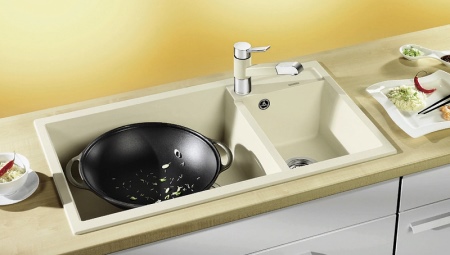
A sink is an integral part of every kitchen. It is important for housewives that this interior detail is not only stylish and beautiful, but also practical and durable. A huge selection of sink models allows you to choose the best option for each style solution. Recently, double sinks have become especially popular. This unusual item allowed expanding the functions of familiar sinks.
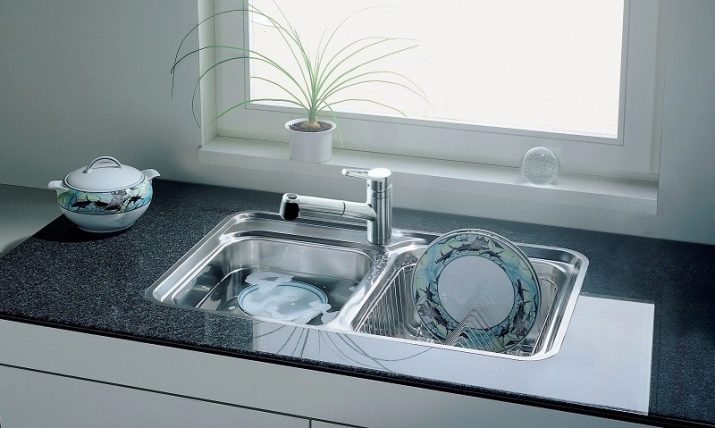
What is it and what are they for?
A double sink differs from the usual one only by the presence of two containers. The two combined sections are perfect for those kitchens where they like to streamline processes. Most often, such plumbing can be found in the presence of housewives who love to cook. Of course, such a kitchen sink allows you to simultaneously perform several procedures.
A double sink in the kitchen, where several people can work at the same time, will become an indispensable assistant. In this case, two sections will allow even several housewives to peacefully coexist within the same kitchen.
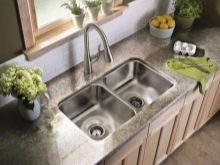

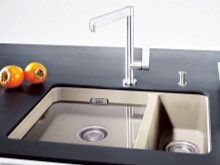
Not so long ago, such sinks were available only to enterprises that belonged to the food industry. Double sinks are now available for every kitchen. In addition, in recent years, interior designers have increasingly opted for this particular element as a fashionable part of the kitchen space. This is not surprising, since two containers allow you to make culinary procedures more hygienic and more comfortable. As a result, the possibilities with such a sink increase significantly, as does the convenience.
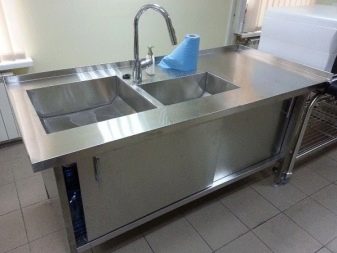
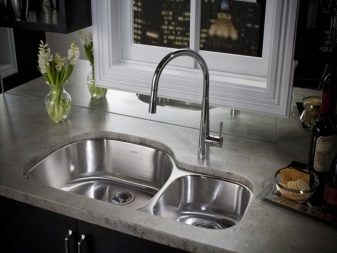
Advantages and disadvantages
Despite their popularity, double sinks have received a lot of both positive and negative reviews. It is possible to judge how convenient such plumbing is only after reading the full list of its pros and cons.
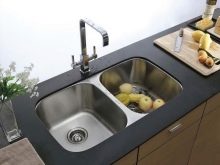
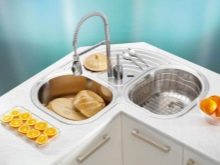
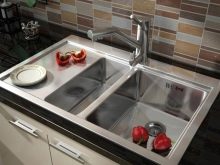
Housewives, who have been using sinks with two sections for several years, highlight several practical advantages.
- Two containers allow you to wash dishes in one, and food in the other.
- One of the sections can be used for frozen food. At this time, the second section can be occupied for other purposes.
- Saves water, which is beneficial. It should be noted that this advantage has long been successfully used by a number of European countries. To do this, it is enough to fill one section of the sink with water and use it for washing, and the other for rinsing.
- If there is a double sink, one part of it can be taken up with pans or baking sheets that need to be pre-soaked before direct washing.
- During the cooking process, it is convenient to take one of the sections with dirty dishes.
- Wet dishes can be placed in an empty container to gradually drain the water.
- During the washing process, you can use a variety of cleaning agents thanks to the additional compartment.
- Allows two people to use the sink at the same time.

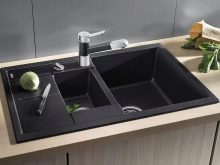
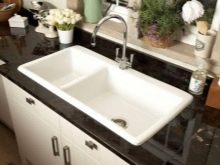
Despite such a number of positive aspects, double sinks have their own significant disadvantages.
- The main disadvantage of such plumbing is its rather large size. The weighty dimensions do not allow such models to be placed in small kitchens. Also, it may not always fit in the same space as the dishwasher.
- Two sections require double flushing. This somewhat complicates the installation, since you will need to install a special adapter that will connect the drain pipes leading to the sewer.
- Communications under the double sink cabinet occupy a significant volume, which can create some inconvenience.
- Another drawback lies in the two drains, which increases the likelihood of blockages in the pipes.
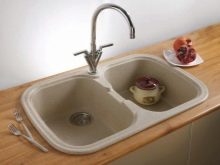

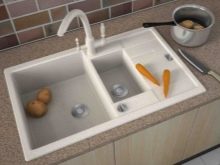
Types and sizes of sinks
Choosing the right sink with two bowls is not difficult today, given the variety of options on offer.
The following types of double sinks are distinguished by shape.
Rectangular. They are the most popular option. They are highly practical, as they are easy to place in almost any kitchen.
Housewives appreciate this form for space saving and rationality.
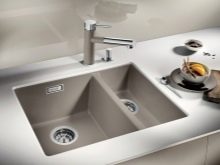

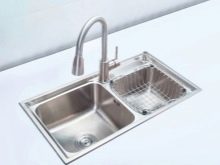
Round or oval... First of all, they will appeal to those who love everything stylish and original. The main advantage of their forms lies in safety, since they are more difficult to injure themselves.
However, it should be borne in mind that such sinks take up a lot of kitchen space.
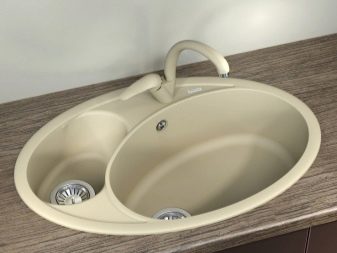

Corner. Ideal for small kitchens. They are the most economical in terms of space. In addition, they often have an original design.
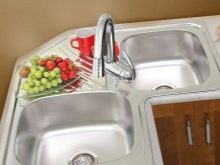

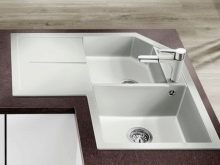
According to the installation method, two types of sinks are distinguished.
Mortisewhich is great for modern kitchen spaces. This type of sink is convenient because you can order sizes to order. Such sinks are installed in the table, or rather, in a special hole in it. Mortise models look most impressive, which after installation smoothly merge with the working kitchen surface.
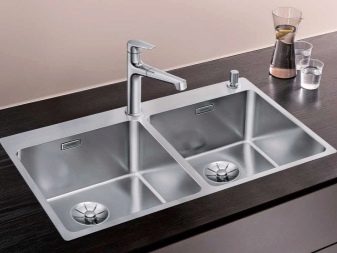
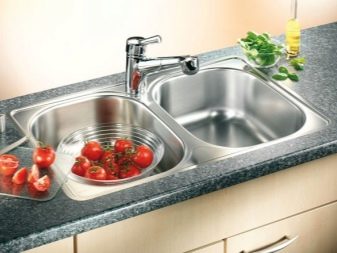
Consignment note most often made of stainless steel. As a rule, a two-bowl sink of this type is installed on top of one of the pieces of kitchen furniture, for example, a cabinet.
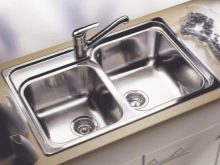
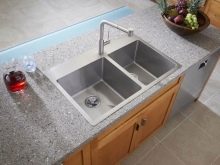
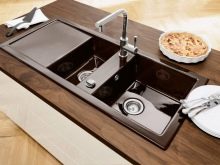
The dimensions of modern 2-compartment sinks are quite standard. The shell length can be 78, 86 and 119 cm, and the width - 52, 50 and 48 cm, respectively. The depth with these parameters will be equal to 20, 19 and 19 cm. If possible, choose a deep sink, since a shallow one is inconvenient to use, because water from it will splash onto the walls and table surface.
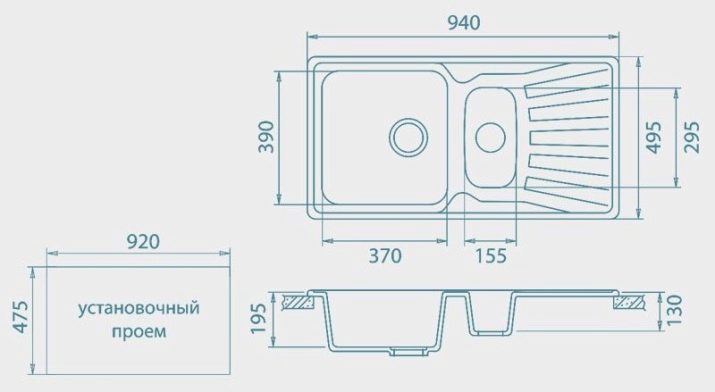
Manufacturing materials
Two-section sink stainless steel occurs most often.This is not surprising, since this material is the most resistant to various cleaning agents, which are very aggressive. In addition, traces of mechanical stress are almost invisible on the steel. Such a sink tolerates temperature fluctuations well and is lightweight. It is also worth noticing that The steel sink is durable, easy to maintain and inexpensive.
However, it should be borne in mind that such a material does not differ in a rich color palette, is not resistant to detergents with abrasive particles, and over time, scratches become visible on the surface. If the sink is made of thin stainless steel, then when a jet of water hits the bottom, a loud noise will be generated.
Of course, a special gasket for sound insulation allows you to cope with the latter problem.
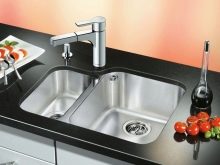
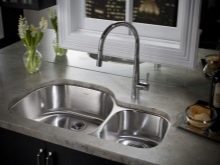

The second place among the materials from which sinks are made for the kitchen is ceramics. These sinks look great in country or antique kitchens. Typically, a ceramic sink can be made of majolica, porcelain or faience. Products from them look beautiful and expensive, besides, they are distinguished by environmental safety.
Among the advantages it is worth noting resistance to corrosion and deformation. Easy to decorate. This allows a simple sink to become a true work of art. Although it is worth considering the impressive weight of the ceramic sinks, which makes them difficult to install.
Moreover, ceramics is a fragile and expensive material.
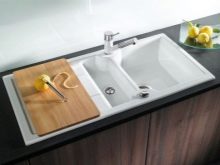
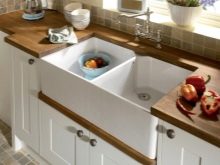
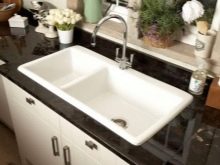
Acrylic sinks first of all, they attract with their appearance. The original colors make them very popular. Moreover, they are light and quiet. However, when using them, it is necessary to take into account their fragility and short service life. Acrylic easily absorbs dyes, both food and chemical.
Boiling water is also not friendly with them. Acrylic sink do not put hot dishes. Of course, you can extend the service life of this material by using a special mesh placed on the bottom of the sink.
It will prevent the formation of numerous cracks and scratches.

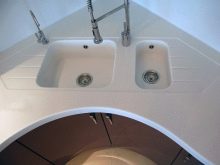
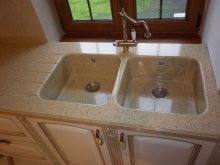
Composite as a material for washing is excellent and fully justifies its high price. Most often, sinks are made from marble, granite or quartz chips. All of them are distinguished by excellent performance properties. Any composite is characterized by strength, reliability, durability.
The fine pore structure prevents moisture, grease and dirt from entering the material.
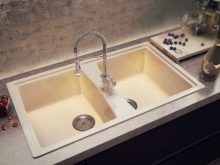
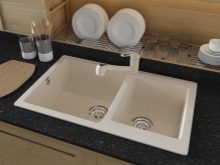

The most practical and at the same time the most expensive are granite and marble sinks... Stone sanitary ware is renowned for its durability and quietness, as well as its heavy weight. It is worth noting that even a black sink will remain so throughout the entire period of use, since these materials do not lose their color saturation when exposed to ultraviolet radiation. The presence of various shapes and shades is also a pleasant moment.
The durability of the stone is complemented by its reliability and resistance to temperature extremes.
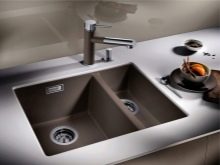
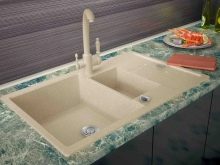
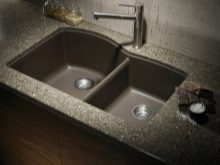
Fake diamond also great for making sinks. Most often, you can find plumbing from porcelain stoneware or agglomerate. The characteristics include a noble appearance, heat resistance, durability, resistance to mechanical stress, a variety of shades.
The main advantage of this material over natural ones is its affordable cost.

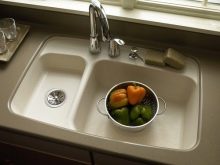
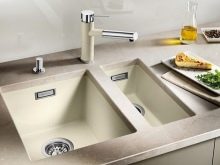
Subtleties of installation
Self-installation of a sink with or without a drainer is not a complicated procedure at all. Models that are mounted in a worktop usually come with a template. It must be attached to the surface into which the installation will be carried out, and marked along the contour with a simple pencil. Then the template is no longer needed.
Next, you need to make some holes using a drill. Then you need to cut out the contour with a jigsaw.After that, a sealant is smeared on the countertop and a sink is applied, which must be pressed firmly. In this case, the glue protrudes, and it is important to remove it before hardening. Now you need to let the structure dry thoroughly for 2-3 hours, and then bring in the necessary communications.

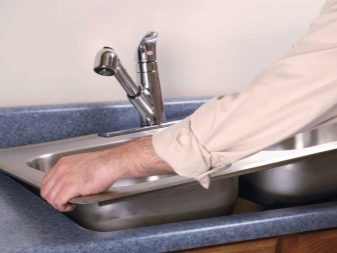
With the overhead installation method, the sink is mounted on a frame pre-treated with a sealant. It is important that the sealant is water-repellent. It is desirable for them to process the surface of the entire sink around the perimeter and joints. The final stage is the connection of communications.
Another installation method is sliding - assumes that there are grooves on the sides of the sink. Special guides are attached to the vanity unit under the sink. It is for them that the sink will enter its place. At the end of the installation, sealant is applied to all joints.


Operation and care
Systematic maintenance of a double wash will avoid many problems. For example, after use it should be wiped with a damp sponge and then wiped dry with a napkin. It is advisable to treat scratches and damages with special means. To remove food coloring stains such as coffee, you can use special chlorine-containing gels or liquids.
It is worth cleaning your sink with limescale products every month.


You can find out how to properly connect a double sink in the kitchen with your own hands by watching the video below.








